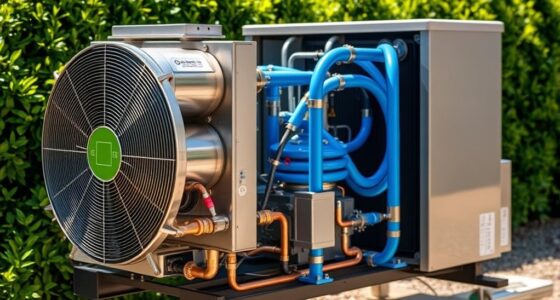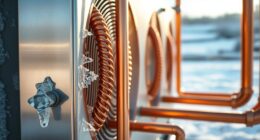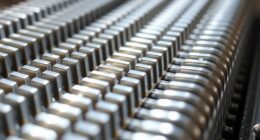We will explore the basic mechanics of the refrigeration cycle in heat pumps in this article. We will break down the components, the step-by-step process, and the important roles of evaporation, condensation, and the expansion valve.
Additionally, we’ll examine the compressor, the heart of the cycle, and the intricacies of heat transfer.
With a technical and informative approach, we aim to decode the functionality of this vital system, serving those seeking a deeper understanding of heat pump refrigeration.
Key Takeaways
- The heat pump refrigeration cycle consists of several components including the evaporator, compressor, condenser, and expansion valve.
- The compressor increases the pressure and temperature of the refrigerant, while the condenser removes heat from the refrigerant.
- Evaporation is a crucial process in the cycle as it absorbs heat from the surroundings and facilitates heat transfer.
- Regular maintenance and monitoring of the compressor efficiency are important for optimal performance and system lifespan.
The Basics of Heat Pump Refrigeration Cycle
Let’s start by exploring the basics of the heat pump refrigeration cycle. Understanding heat transfer is crucial to comprehending how a heat pump works.

Heat pumps use a refrigerant to transfer heat from one place to another, typically from a colder space to a warmer one. The process begins with the evaporator, where the refrigerant absorbs heat from the surroundings, causing it to evaporate into a gas.
The compressor then increases the pressure and temperature of the gas, which is then condensed in the condenser, releasing heat into the desired space. The refrigerant is then expanded in the expansion valve, lowering its temperature and pressure, and the cycle repeats.
The efficiency of heat pumps is measured by the coefficient of performance (COP), which is the ratio of heat transferred to the amount of work done.
Understanding the Components of a Heat Pump Refrigeration Cycle
Let’s begin by exploring the key components of a heat pump refrigeration cycle and understanding their operating principles.

These components play a crucial role in the functionality of the cycle and are responsible for the heat transfer process.
Key Cycle Components
We will now discuss the key components of a heat pump refrigeration cycle. The efficiency of a heat pump depends on the proper functioning of these components.
The first important component is the compressor. This device is responsible for compressing the refrigerant, increasing its pressure and temperature.
Next, we have the condenser, where the high-pressure, high-temperature refrigerant releases heat to the surroundings and condenses into a liquid.

The expansion valve is another critical component, as it controls the flow of refrigerant into the evaporator.
In the evaporator, the refrigerant absorbs heat from the surroundings, evaporates, and becomes a low-pressure gas again.
Lastly, the refrigerant returns to the compressor to start the cycle again.
Understanding the properties of the refrigerant and ensuring the proper functioning of these components are vital for achieving optimal heat pump efficiency.

Operating Principles Explained
Two components work in conjunction to ensure the proper operation of a heat pump refrigeration cycle: the compressor and the condenser. The compressor is responsible for pressurizing the refrigerant gas, raising its temperature and pressure. On the other hand, the condenser is responsible for removing heat from the refrigerant and converting it into a high-pressure liquid. Understanding the operating principles of these components is essential for analyzing the efficiency of the heat pump refrigeration cycle.
Here are four key points to consider:
- The compressor increases the pressure and temperature of the refrigerant.
- The condenser removes heat from the refrigerant, causing it to condense into a high-pressure liquid.
- The compressor and condenser work together to increase the refrigerant’s temperature and pressure.
- The efficiency of the heat pump refrigeration cycle can be analyzed by evaluating the performance of the compressor and the condenser.
Now, let’s delve into the step-by-step process of a heat pump refrigeration cycle.
Step-by-Step Process of a Heat Pump Refrigeration Cycle
The first step in a heat pump refrigeration cycle is the compression of the refrigerant. During this step, the low-pressure refrigerant enters the compressor, where it’s compressed to a higher pressure. This compression increases the temperature of the refrigerant, making it ready for the next stage of the cycle.

The compressed refrigerant then moves to the condenser, where it releases heat to the surrounding environment. This heat transfer process allows the refrigerant to cool down and change from a gas to a liquid state.
Next, the liquid refrigerant passes through an expansion valve, which reduces its pressure. This pressure reduction causes the refrigerant to evaporate, absorbing heat from its surroundings and cooling them down.
The final step is the refrigerant’s return to the compressor, completing the cycle. This continuous process of compression, condensation, expansion, and evaporation allows the heat pump to efficiently transfer heat from one location to another, while minimizing energy consumption.
The Role of Evaporation in Heat Pump Refrigeration Cycle
In the heat pump refrigeration cycle, the evaporation process plays a crucial role in achieving efficient cooling. The evaporator is responsible for creating a cooling effect by absorbing heat from the surroundings. Through evaporation, the refrigerant undergoes a phase change from liquid to gas, facilitating heat transfer and effectively cooling the desired space.

Understanding the importance of evaporation in the heat pump refrigeration cycle is essential for optimizing the overall performance of the system.
Evaporator’s Cooling Effect
We can explore the cooling effect of the evaporator and its role in the heat pump refrigeration cycle.
The evaporator, as a crucial component in the refrigeration cycle, is responsible for absorbing heat from the surrounding environment, thereby cooling it down.
Here are four key aspects to understand about the evaporator’s cooling effect:

-
Efficiency: The evaporator’s efficiency determines how effectively it can extract heat from the environment. Higher efficiency allows for greater cooling capacity and energy savings.
-
Heat Transfer: Through evaporation, the refrigerant inside the evaporator absorbs heat from the surroundings, causing the refrigerant to change from a liquid to a gaseous state.
-
Cooling Output: The cooling capacity of the evaporator is measured in BTUs (British Thermal Units) per hour and indicates how much heat it can remove from the environment.
-
Frost Formation: As the evaporator absorbs heat, moisture in the air can condense and freeze on the evaporator’s coils, leading to frost buildup. Regular defrosting is necessary to maintain the evaporator’s efficiency.

Understanding the evaporator’s cooling effect is essential for optimizing the performance of a heat pump refrigeration cycle and ensuring efficient cooling for various applications.
Evaporation and Heat Transfer
Our understanding of evaporation and its role in the heat pump refrigeration cycle is crucial for optimizing its functionality. Evaporation techniques play a vital role in the heat transfer mechanisms of a heat pump.
During the evaporation process, the refrigerant absorbs heat from its surroundings, causing it to change from a liquid to a vapor state. This absorption of heat is essential for the cooling effect produced by the evaporator.
As the refrigerant vaporizes, it extracts energy from the air or water passing through the evaporator coil, resulting in a decrease in temperature. This cooled air or water can then be used for various purposes, such as air conditioning or hot water supply.

Understanding the principles of evaporation is essential for designing efficient heat pump systems.
In the subsequent section, we’ll explore the importance of evaporation in more detail.
Importance of Evaporation
Occasionally, evaporation acts as a crucial component in the heat pump refrigeration cycle by facilitating heat transfer and optimizing functionality. The evaporation process plays a significant role in the efficient operation of the heat pump system. Here are four key reasons why evaporation is important:
-
Heat Absorption: Evaporation allows the refrigerant to absorb heat from the surroundings, which is then carried away as the refrigerant changes from a liquid to a gas state.

-
Cooling Effect: As the evaporation rate increases, it enhances the cooling effect, making the heat pump more effective in cooling the desired space.
-
Energy Efficiency: By utilizing the latent heat of evaporation, the heat pump can achieve higher energy efficiency, reducing energy consumption and operating costs.
-
Heat Pump Performance: Evaporation enables the heat pump to maintain a stable temperature, ensuring optimal performance and extended lifespan.
Recognizing the significance of evaporation, it’s crucial to understand the subsequent stage in the heat pump refrigeration cycle: condensation.

Condensation: A Crucial Stage in Heat Pump Refrigeration Cycle
Condensation plays a crucial role in the heat pump refrigeration cycle. It’s the process by which the refrigerant, after being evaporated in the evaporator coil, is converted back into a liquid state. This condensation process is essential for the efficient operation of the heat pump.
During condensation, the refrigerant releases heat to the surroundings, which is then transferred outside the system. This heat transfer is vital for maintaining the desired temperature inside the refrigerated space. By removing heat, condensation helps cool the space and increases the heat pump’s efficiency.
To ensure effective condensation, the condenser coil is designed to maximize heat transfer. It’s typically located outside the refrigerated space to facilitate the dissipation of heat into the environment. This allows the refrigerant to condense quickly and efficiently, improving the overall performance of the heat pump system.
Expansion Valve: Controlling the Refrigerant Flow in Heat Pump Refrigeration Cycle
When the refrigerant leaves the condenser coil, it passes through the expansion valve, which controls the flow of refrigerant in the heat pump refrigeration cycle. The expansion valve plays a crucial role in the overall functionality of the system by regulating the refrigerant flow and maintaining the desired temperature.

Here are four key points to understand about the expansion valve’s functionality:
-
Pressure Regulation: The expansion valve controls the pressure of the refrigerant as it enters the evaporator coil. This ensures that the refrigerant vaporizes at the right rate for efficient heat transfer.
-
Flow Control: By adjusting the size of the valve opening, the flow rate of the refrigerant can be controlled. This allows for precise temperature regulation and energy efficiency.
-
Superheat Control: The expansion valve also helps maintain the right amount of superheat in the refrigerant. Superheat refers to the heat added to the refrigerant vapor above its boiling point. Controlling superheat ensures optimal system performance.

-
Sensing Bulb: The expansion valve uses a sensing bulb that monitors the temperature of the refrigerant leaving the evaporator coil. This information is used to adjust the valve opening, ensuring accurate temperature control.
Understanding the functionality of the expansion valve is essential for maintaining optimal performance and energy efficiency in heat pump refrigeration systems.
Compressor: The Heart of Heat Pump Refrigeration Cycle
We, as the authors, believe that the compressor is an integral component of the heat pump refrigeration cycle, as it is responsible for circulating the refrigerant and facilitating the heat exchange process. The compressor plays a crucial role in maintaining the efficiency of the heat pump system by compressing the low-pressure refrigerant vapor from the evaporator, raising its temperature and pressure, and then delivering it to the condenser. This process increases the refrigerant’s enthalpy, enabling it to release heat to the surroundings. A malfunctioning compressor can lead to various issues such as reduced cooling or heating capacity, increased energy consumption, and potential system breakdown. Troubleshooting compressor issues involves checking for proper lubrication, examining electrical connections, and monitoring pressure and temperature differentials. Regular maintenance and monitoring of compressor efficiency are essential to ensure optimal performance and extend the lifespan of the heat pump system.
| Common Compressor Issues | Possible Causes | Troubleshooting Steps |
|---|---|---|
| Insufficient Cooling/Heating | Low refrigerant charge, dirty condenser or evaporator coils, faulty expansion valve | Check and replenish refrigerant charge, clean coils, replace faulty expansion valve |
| Excessive Energy Consumption | Dirty air filters, restricted airflow, refrigerant leaks, worn-out compressor | Clean or replace air filters, ensure proper airflow, identify and fix refrigerant leaks, replace worn-out compressor |
| Abnormal Noise or Vibration | Loose components, damaged motor mounts, faulty compressor valves | Tighten loose components, repair or replace motor mounts, replace faulty compressor valves |
Heat Transfer in a Heat Pump Refrigeration Cycle
Heat transfer in a heat pump refrigeration cycle occurs when the refrigerant absorbs heat from the surroundings in the evaporator and releases it to the surroundings in the condenser. Understanding how heat is transferred is crucial for optimizing heat pump efficiency and performance. Here are four key points to consider:

-
Evaporation: Heat transfer begins in the evaporator as the low-pressure refrigerant evaporates, absorbing heat from the surrounding air or water.
-
Compression: The compressor then raises the pressure and temperature of the refrigerant, further enhancing its ability to transfer heat.
-
Condensation: In the condenser, the high-pressure refrigerant releases heat to the surroundings, typically air or water, as it condenses back into a liquid state.
-
Expansion: The expansion valve reduces the pressure of the refrigerant, preparing it to repeat the cycle in the evaporator.

Frequently Asked Questions
How Does the Size of a Heat Pump Affect Its Efficiency?
The size of a heat pump directly impacts its energy efficiency. A properly-sized heat pump will effectively transfer heat, while an oversized or undersized one will waste energy. Proper sizing is crucial for optimal performance and cost savings.
Can a Heat Pump Be Used for Both Heating and Cooling?
Yes, a heat pump can be used for both heating and cooling. It is an efficient way to regulate indoor temperature. To maintain its efficiency, regular heat pump maintenance is required.
What Is the Average Lifespan of a Heat Pump?
The average lifespan of a heat pump depends on various factors such as proper maintenance, usage, and quality of installation. Regular maintenance, such as cleaning filters and coils, can help prolong its lifespan.
Is It Necessary to Have Regular Maintenance for a Heat Pump?
Regular maintenance for a heat pump is necessary to ensure optimal performance and extend its lifespan. The importance of maintenance cannot be overstated as it helps prevent breakdowns, improve efficiency, and save money on repairs.

Are There Any Environmental Concerns Associated With Heat Pump Refrigeration Cycles?
Yes, there are environmental concerns associated with heat pump refrigeration cycles. The main concern is their energy consumption, as they rely on electricity to operate. However, compared to other heating and cooling systems, heat pumps generally have lower environmental impact.
Conclusion
In conclusion, the heat pump refrigeration cycle is a complex and efficient process that utilizes various components to transfer heat and provide cooling or heating.
From the role of evaporation to the crucial stage of condensation, each step plays a vital role in the cycle.
The expansion valve controls the refrigerant flow, while the compressor acts as the heart of the system.

Overall, this cycle is like a well-oiled machine, smoothly transferring heat and providing comfort in a precise and efficient manner.









